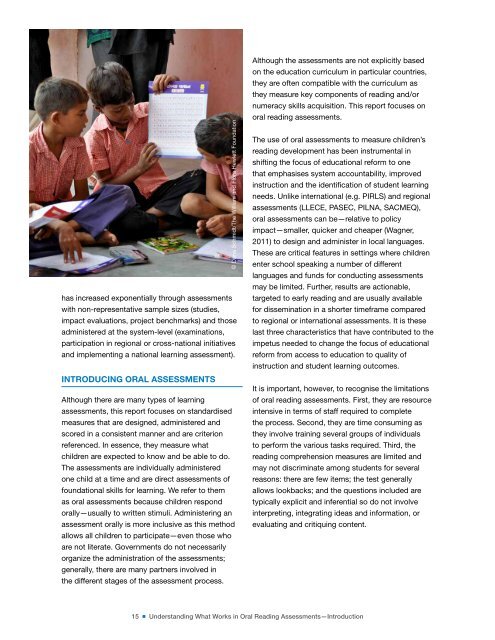UNDERSTANDING WHAT WORKS IN ORAL READING ASSESSMENTS
MZhk301yPHZ
MZhk301yPHZ
Create successful ePaper yourself
Turn your PDF publications into a flip-book with our unique Google optimized e-Paper software.
has increased exponentially through assessments<br />
with non-representative sample sizes (studies,<br />
impact evaluations, project benchmarks) and those<br />
administered at the system-level (examinations,<br />
participation in regional or cross-national initiatives<br />
and implementing a national learning assessment).<br />
<strong>IN</strong>TRODUC<strong>IN</strong>G <strong>ORAL</strong> <strong>ASSESSMENTS</strong><br />
Although there are many types of learning<br />
assessments, this report focuses on standardised<br />
measures that are designed, administered and<br />
scored in a consistent manner and are criterion<br />
referenced. In essence, they measure what<br />
children are expected to know and be able to do.<br />
The assessments are individually administered<br />
one child at a time and are direct assessments of<br />
foundational skills for learning. We refer to them<br />
as oral assessments because children respond<br />
orally—usually to written stimuli. Administering an<br />
assessment orally is more inclusive as this method<br />
allows all children to participate—even those who<br />
are not literate. Governments do not necessarily<br />
organize the administration of the assessments;<br />
generally, there are many partners involved in<br />
the different stages of the assessment process.<br />
© Dana Schmidt/The William and Flora Hewlett Foundation<br />
Although the assessments are not explicitly based<br />
on the education curriculum in particular countries,<br />
they are often compatible with the curriculum as<br />
they measure key components of reading and/or<br />
numeracy skills acquisition. This report focuses on<br />
oral reading assessments.<br />
The use of oral assessments to measure children’s<br />
reading development has been instrumental in<br />
shifting the focus of educational reform to one<br />
that emphasises system accountability, improved<br />
instruction and the identification of student learning<br />
needs. Unlike international (e.g. PIRLS) and regional<br />
assessments (LLECE, PASEC, PILNA, SACMEQ),<br />
oral assessments can be—relative to policy<br />
impact—smaller, quicker and cheaper (Wagner,<br />
2011) to design and administer in local languages.<br />
These are critical features in settings where children<br />
enter school speaking a number of different<br />
languages and funds for conducting assessments<br />
may be limited. Further, results are actionable,<br />
targeted to early reading and are usually available<br />
for dissemination in a shorter timeframe compared<br />
to regional or international assessments. It is these<br />
last three characteristics that have contributed to the<br />
impetus needed to change the focus of educational<br />
reform from access to education to quality of<br />
instruction and student learning outcomes.<br />
It is important, however, to recognise the limitations<br />
of oral reading assessments. First, they are resource<br />
intensive in terms of staff required to complete<br />
the process. Second, they are time consuming as<br />
they involve training several groups of individuals<br />
to perform the various tasks required. Third, the<br />
reading comprehension measures are limited and<br />
may not discriminate among students for several<br />
reasons: there are few items; the test generally<br />
allows lookbacks; and the questions included are<br />
typically explicit and inferential so do not involve<br />
interpreting, integrating ideas and information, or<br />
evaluating and critiquing content.<br />
15 ■ Understanding What Works in Oral Reading Assessments—Introduction



